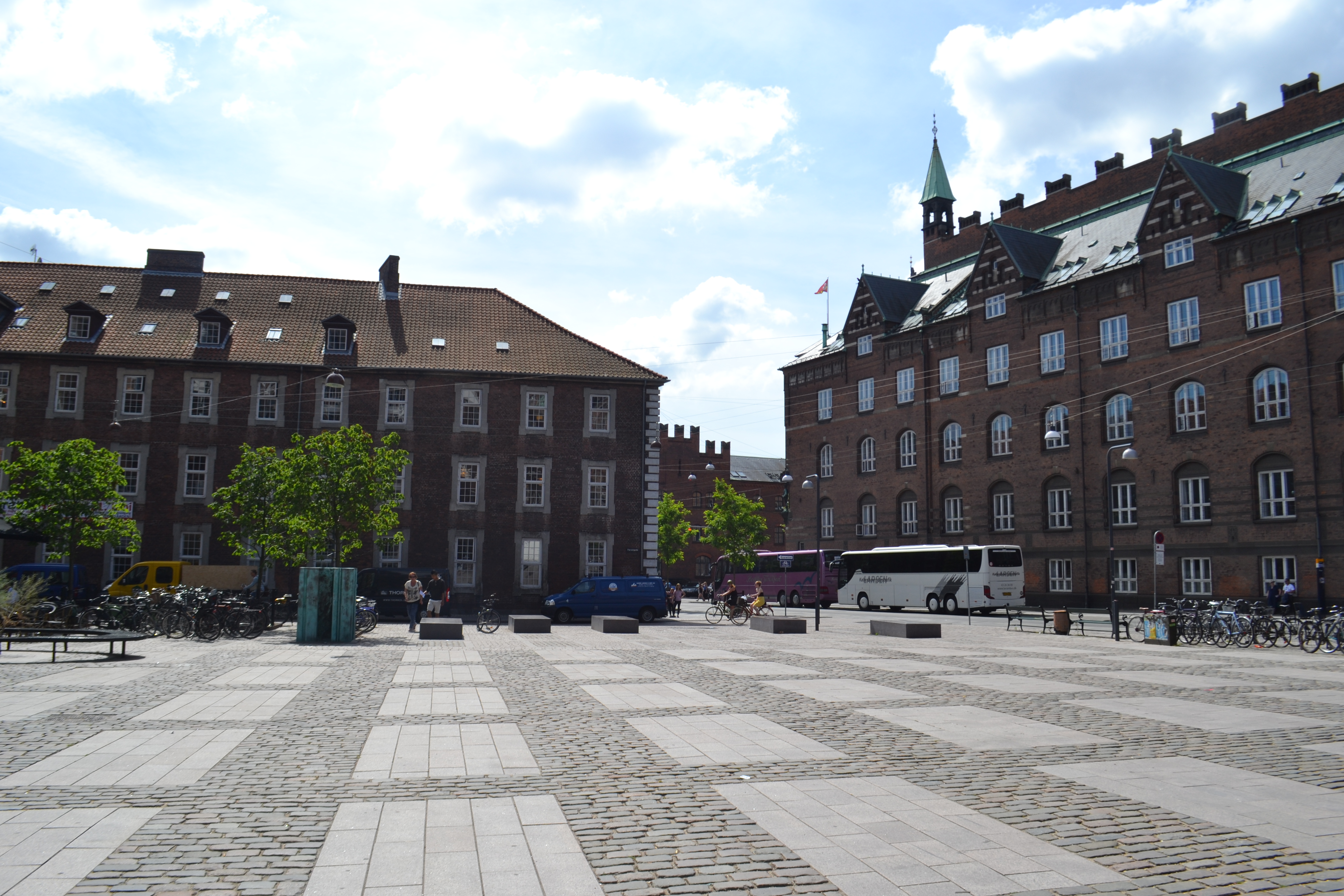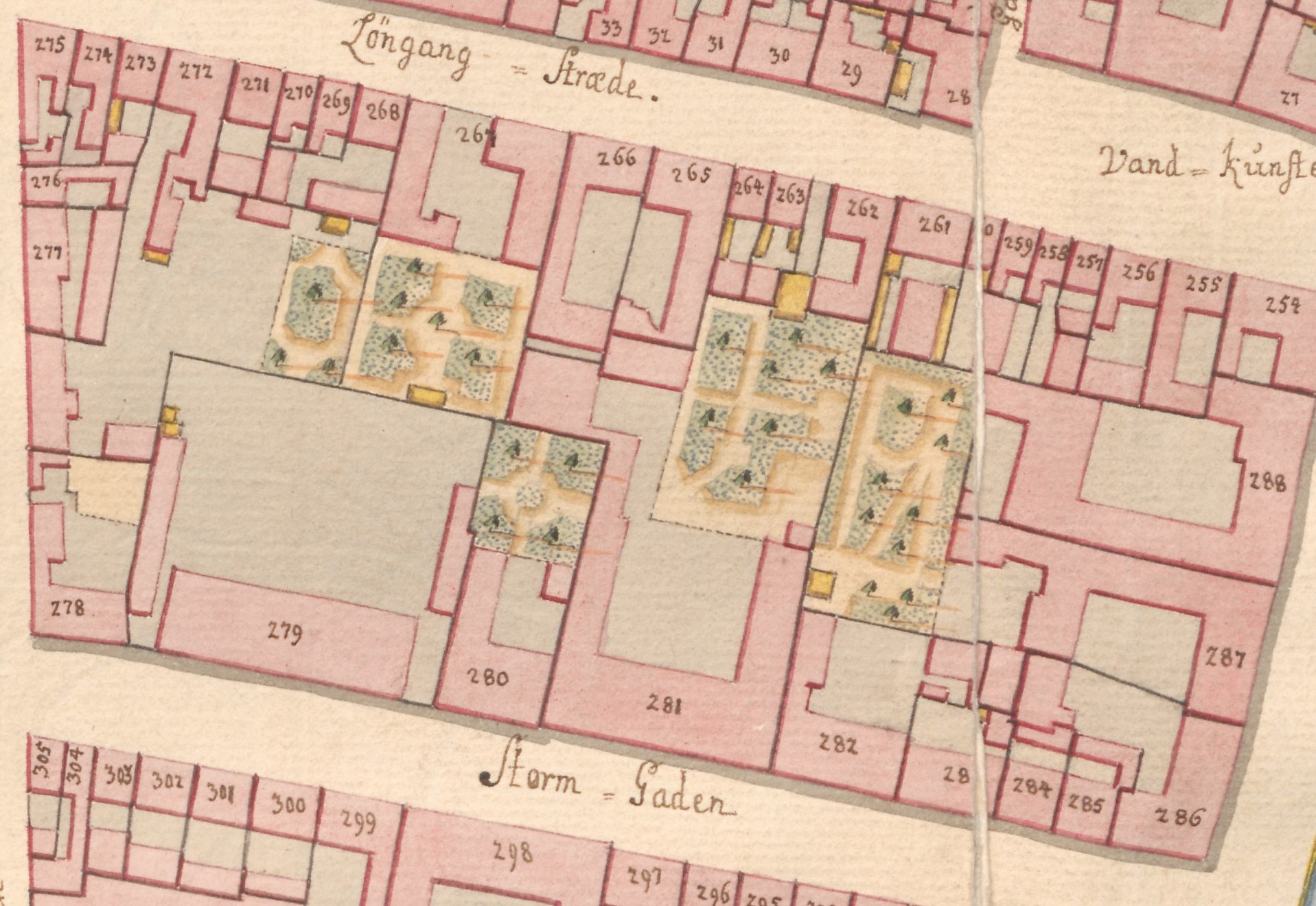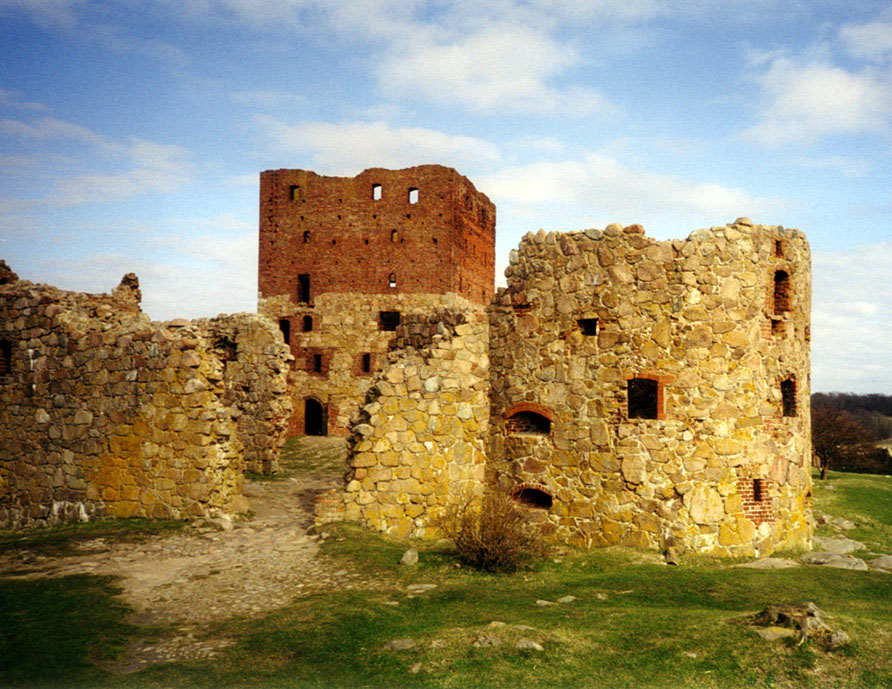|
Stormgade (Gedde)
Stormgade ( lit. "Storm Street") is a street in central Copenhagen, Denmark. It runs from Frederiksholm Canal to H. C. Andersens Boulevard where it turns into Tietgensgade before continuing along the rear side of Tivoli Gardens and Copenhagen Central Station. In the opposite direction, Storm Bridge connects it to Slotsholmen where traffic may continue across Holmen's Bridge to Holmens Kanal, part of Ring 2, or across Knippel's Bridge to Christianshavn and Amager. The name of the street refers to the Swedish Storm of Copenhagen in 1659. History The area south of Slotsholmen was originally part of the shallow-watered area known as Kalveboderne. The coast line ran approximately where Stormgade runs today. On the night of 10 February 1658, Swedish troops made an assault on Slotsholmen across the ice. After the attack, it was decided to improve the defense of Slotsholmen by extending Copenhagen's Western Rampart into the water. The area between the rampart and the new Frederiksholm ... [...More Info...] [...Related Items...] OR: [Wikipedia] [Google] [Baidu] |
Vester Voldgade
Vester Voldgade ( lit. "West Rampart Street") is a street in Copenhagen, Denmark which runs from Jarmers Plads to the waterfront between Frederiksholms Kanal and Langebro, passing the City Hall Square on the way. Together with Nørre Voldgade and Øster Voldgade it forms a traffic artery which arches around the Zealand side of central Copenhagen all the way to Kastellet (at Oslo Plads on the coast north of the city centre. The three streets follow the course of Copenhagen's long gone Bastioned Fortification Ring and thus marks the transition between the Old Town and the new neighbourhoods that developed after the fortifications were removed in the second half of the 19th century. History Vester Voldgade was originally a narrow alley which ran along the inner margin of Copenhagen's West Rampart, part of the Bastioned Fortification Ring which enclosed Copenhagen. The city's haymarket was located at the site of the current City Hall Square until the New Haymarket was inau ... [...More Info...] [...Related Items...] OR: [Wikipedia] [Google] [Baidu] |
Ny Vestergade
Ny Vestergade ( lit. English: New West Street) is a street in central Copenhagen, Denmark. It runs from Frederiksholms Kanal to Vester Voldgade and together with Christiansborg's riding grounds, Marble Bridge and Dantes Plads forms an axis between Christiansborg's tower in the east and Ny Carlsberg Glyptotek's dome in the west. The National Museum's main entrance is located in the street. History Ny Vestergade is one of the streets that was created when the Frederiksholm neighbourhood was established in the 1660s. It is referred to as ''Den Nye Vestergade'' ("The New West Street") in 1665 but was long more commonly called Wigandts Gade after wine trader and ship owner Wigand Michelbecker (1636-1692), who owned a property where National Museum is now located. The name "New" refers to the old Vestergade, which extends westwards from Gammeltorv. Notable buildings and residents The National Museum occupies the entire north side of the street. The recessed main entrance was cre ... [...More Info...] [...Related Items...] OR: [Wikipedia] [Google] [Baidu] |
Hans Jørgen Holm
Hans Jørgen Holm (9 May 1835 – 22 July 1916) was a Danish architect. A pupil of Johan Daniel Herholdt, he became a professor at the Royal Danish Academy of Fine Arts and a leading Danish proponent of the National Romantic style. Biography Holm was born in Copenhagen, Denmark. He was the son of Carl Jacob Holm and Johanne Henriette f. Kierulf. He studied at the city's Technical University of Denmark, College of Advanced Technology before being admitted to the Royal Danish Academy of Fine Arts, Royal Academy of Fine Arts, where he graduated in 1855. Anne Lise Thygesen In the same time he worked for Gustav Friederich Hetsch and Johan Daniel Herholdt Johan Daniel Herholdt (13 August 1818 – 11 April 1902) was a Danish architect, professor and royal building inspector. He worked in the Historicist style and had a significant influence on Danish architecture during the second half of the 19th an .... From 1866-79, he was an assistant teaching architectural art at the arc ... [...More Info...] [...Related Items...] OR: [Wikipedia] [Google] [Baidu] |
Lauritz De Thurah
Laurids Lauridsen de Thurah, known as Lauritz de Thurah (4 March 1706 – 5 September 1759), was a Danish architect and architectural writer. He became the most important Danish architect of the late baroque period. As an architectural writer and historian he made a vital contribution to the understanding of both Denmark's architectural heritage and building construction in his day. De Thurah was a self-taught architect who learned much of what he knew by studying the inspiring buildings he saw on his travels outside Denmark between 1729 and 1731. He brought home the baroque style, which was then popular, but was quickly losing way to rococo. Throughout his life he maintained a loyalty to the baroque, even as the world around him continued to change and he lost work assignments to others who mastered the newer, more popular styles. Early life and education Lauritz de Thurah was born Laurids Lauridsen Thura in Aarhus, the third son of parish priest Laurids Thura, later Bishop ... [...More Info...] [...Related Items...] OR: [Wikipedia] [Google] [Baidu] |
Elias David Häusser
Elias David Häusser (25 June 1687 – 16 March 1745) was a German-Danish architect working in the Baroque and Rococo styles. He is most known for designing the first Christiansborg Palace which was almost completely destroyed in a fire in 1794. Häusser is credited with introducing both those styles to Denmark. Biography Häusser was born in Erfurt, Preußen or Prussia. His parents were David Häusser (1645-1709) and Johanna Maria Evander (1666-1741). He spent some time at the court of the Duke of Saxony-Gotha and was educated as a military building master in Saxony-Poland. In 1711 he came into Danish military service. In the capacity of an officer in the engineering troops, he was in charge of several projects in Copenhagen, including the Central Guard on Kongens Nytorv and the Commander's House and prison at Kastellet.Elisabeth Buchwald In the early 1730s, King Christian VI commissioned him as master builder of a new grand castle, Christiansborg Palace, on the site o ... [...More Info...] [...Related Items...] OR: [Wikipedia] [Google] [Baidu] |
Det Harboeske Enkefruekloster
Det Harboeske Enkefruekloster (English: Harboe's Refuge for Widowed Ladies) is a Late Baroque building on Stormgade in Copenhagen, Denmark. The charity was founded by Christine Harboe (née Baroness Fuiren). The building was listed in the Danish registry of protected buildings and places in 1918. History Early history The lot was originally acquired by ''landdrost'' Simon de Pethum when Stormgade was created together with the rest of the new Frederiksholm neighbourhood. The house was possibly designed by court architect Lambert van Haven. He lived in the building with his wife and 11 children. Wilersen and Harboe families In 1700, Lambert van Haven's widow sold the property to Baroness Margrethe Eilersen (1648-1708), the mother of Christina Christina Eilersen. The two baronesses lived in the house until Christina's marriage to former war minister Jens Harboe. Eilersen died in 1708 and in 1711 the wealthy couple extended the house in Stormgade with the assistance of Elias Dav ... [...More Info...] [...Related Items...] OR: [Wikipedia] [Google] [Baidu] |
Natural History Museum Of Denmark
The Natural History Museum of Denmark ( da, Statens Naturhistoriske Museum) is a natural history museum located in Copenhagen, Denmark. It was created as a 1 January 2004 merger of Copenhagen's Zoological Museum, Geological Museum, Botanical Museum and Central Library, and Botanical Gardens. It is affiliated with the University of Copenhagen. History The Natural History Museum of Denmark was established on 1 January 2004 by the merging of four long-standing institutions: the Botanical Garden, the Botanical Museum & Central Library, the Geological Museum, and the Zoological Museum. The history of the individual departments, which now are part of the united Natural History Museum of Denmark, can be traced back to the 17th century. One historical figure in particular played a crucial role in the creation of the Danish national heritage, namely Ole Worm Ole Worm (13 May 1588 – 31 August 1654), who often went by the Latinized form of his name Olaus Wormius, was a Danish phy ... [...More Info...] [...Related Items...] OR: [Wikipedia] [Google] [Baidu] |
Jacob Fortling
Jacob Fortling (23 December 1711 – 16 July 1761) was a German-Danish sculptor, architect and industrialist, described as one of the most industrious people in the Denmark of his day. He came to Denmark at age 18 and embarked on a successful career, first as a sculptor and later also as an architect. He was also engaged in the production of building materials, owning several quarries in Norway. Just outside Copenhagen, on Amager's east coast, he founded Kastrup Værk, a large industrial facility combining a lime plant, a brickyard and a pottery. Kastrupgård, his former home, has been turned into an art museum. Biography Early life and career as a sculptor Fortling was born on 23 December 1711 in Bayreuthin present day Germany. He trained as a mason and stone carver and came to Denmark to work on the many large Royal building projects under King Christian VI, collaborating with sculptors such as Jacques Saly and Simon Carl Stanley. He executed the Queen's Staircase ... [...More Info...] [...Related Items...] OR: [Wikipedia] [Google] [Baidu] |
Holstein Mansion
The Holstein Mansion is a Baroque style town mansion on Stormgade in central Copenhagen, Denmark. The history of the property dates back to the late 17th century but the name and current design of the building is from the 1750s when it was owned by the Holstein family and expanded by royal sculptor Jacob Fortling. Once home to the Natural History Museum, it housed government offices until 2015. Today it has beecompletely renovatedand converted into private apartments. History Early history The original house was built for Hofmarschall Henrik Ulrik Lützow in 1687. The two-storey, nine-bay house was possibly designed by General Building Master Lambert van Haven. Lützow's property was listed in Copenhagen's first cadastre of 1689 as No. 261 in the city's West Quarter (Vester Kvarter). In 1706, the house was expanded with a wide bay at both ends of the main wing and two perpendicular wings to the rear. The architect of this expansion was possibly Johan Conrad Ernst. Holstein ... [...More Info...] [...Related Items...] OR: [Wikipedia] [Google] [Baidu] |
Bornholm
Bornholm () is a Danish island in the Baltic Sea, to the east of the rest of Denmark, south of Sweden, northeast of Germany and north of Poland. Strategically located, Bornholm has been fought over for centuries. It has usually been ruled by Denmark, but also by Sweden and by Lübeck. The ruin of Hammershus, at the northwestern tip of the island, is the largest medieval fortress in northern Europe, testament to the importance of its location. Bornholm and Ertholmene comprise the last remaining Danish territory in Skåneland east of Øresund, having been surrendered to Sweden in 1658, but regained by Denmark in 1660 after a local revolt. The island is known as ("sunshine island") because of its weather and ("rock island") because of its geology, which consists of granite, except along the southern coast. The heat from the summer is stored in the rock formations and the weather is quite warm until October. As a result of the climate, a local variety of the common fig, known ... [...More Info...] [...Related Items...] OR: [Wikipedia] [Google] [Baidu] |
Stormgade - Colonade
Stormgade ( lit. "Storm Street") is a street in central Copenhagen, Denmark. It runs from Frederiksholm Canal to H. C. Andersens Boulevard where it turns into Tietgensgade before continuing along the rear side of Tivoli Gardens and Copenhagen Central Station. In the opposite direction, Storm Bridge connects it to Slotsholmen where traffic may continue across Holmen's Bridge to Holmens Kanal, part of Ring 2, or across Knippel's Bridge to Christianshavn and Amager. The name of the street refers to the Swedish Storm of Copenhagen in 1659. History The area south of Slotsholmen was originally part of the shallow-watered area known as Kalveboderne. The coast line ran approximately where Stormgade runs today. On the night of 10 February 1658, Swedish troops made an assault on Slotsholmen across the ice. After the attack, it was decided to improve the defense of Slotsholmen by extending Copenhagen's Western Rampart into the water. The area between the rampart and the new Frederiksh ... [...More Info...] [...Related Items...] OR: [Wikipedia] [Google] [Baidu] |





